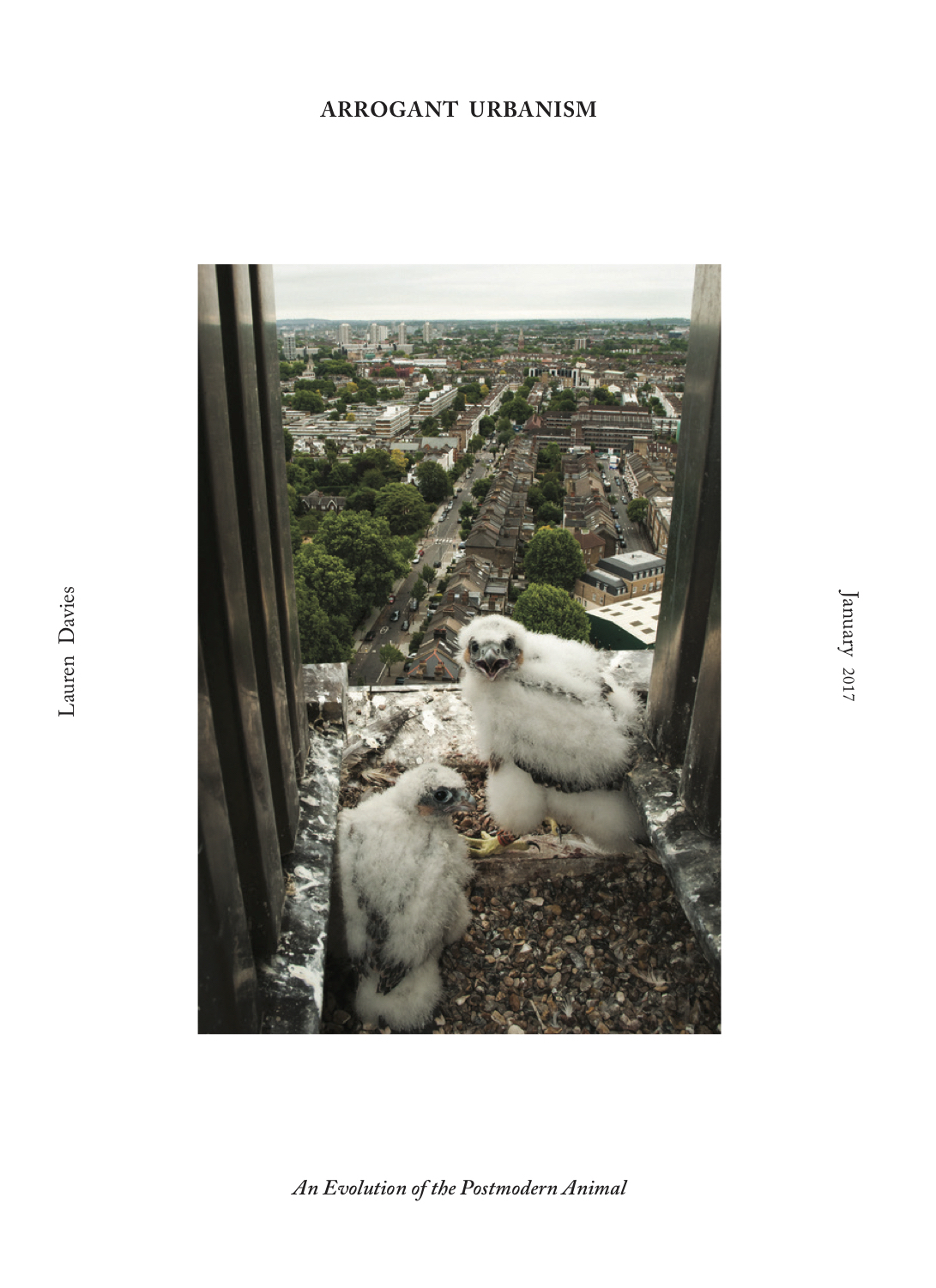Arrogant Urbanism

UK / 2018
From Arrogant Urbanism; An Evolution of the Postmodern Animal
Copies available on request. 1st Class Disstertation. BA (Hons) Design. Goldsmiths, University of London. 2017.
Foreword
Our relationship with the natural world is rapidly shifting. The effects of rising populations, urban sprawl and consumer culture are made clear in several reports from biologists and conservationists. From city noise altering bat echolocation calls, to urban sprawl affecting bee pollination and artificial light pollution causing higher melatonin (stress levels) in birds, there is mounting evidence of the damage caused by human activity. These reports show how anthropogenic outputs such as noise, light and waste are irreversibly forcing detrimental adaptations and even generational evolution on to many species. “We forget that we are the biggest cause of evolution on the planet right now,” says Suzanne MacDonald, a psychologist and biologist at York University in Toronto, Canada, who studies urban raccoons. “We have this view of the wild as a pristine place” and of evolution as something that happens “in the wild,” she says. “But humans in cities are changing the animals now.”
The reports that evidence our damaging effects on various species, in the most part, do just that - evidence the problems. What is suggested in Arrogant Urbanism is that design can progress specific scientific knowledge, in particular that surrounding urban selection pressures, from a static piece of information, to action, public engagement and in some cases a permanent solution.
Design can do what the reports alone cannot. This is not to underestimate the power of science, however. Rather, it is suggesting a collaborative approach between designers and experts from several fields, in order to produce thorough and effective outcomes.
The reports that evidence our damaging effects on various species, in the most part, do just that - evidence the problems. What is suggested in Arrogant Urbanism is that design can progress specific scientific knowledge, in particular that surrounding urban selection pressures, from a static piece of information, to action, public engagement and in some cases a permanent solution.
Design can do what the reports alone cannot. This is not to underestimate the power of science, however. Rather, it is suggesting a collaborative approach between designers and experts from several fields, in order to produce thorough and effective outcomes.
This might be through various outputs such as; critical synthetic biology, product design, speculative design, empathetic design (not to be confused with empathic design*) and
critical design.
Firstly, by emphasising current critical issues to the public through engaging exhibitions and projects that push us to question ethical boundaries and in turn, generate empathetic responses towards the plight of non-human creatures. Then secondly, working with the relevant experts to reach designed solutions that will benefit the species in question.
Focusing conservation efforts on “umbrella species” can help preserve habitat that is also used by many other species. But this kind of selectivenes does not lead to what conservationists themselves often call, half humorously and half disdainfully, “charismatic megafauna” or, more neutrally, “flagship species,” animal types whose appeal to the broad public makes them good tools in campaigns to raise public awarenes and funds for conservation issues.’
It is also important to question whether anything actually needs to be done, whether assumptions are being made about which species need help and whether we have an ecological responsibility as conscious beings. Many would argue not and so, Arogant Urbanism will explore these issues through the lens of design, discussing whether designers should use their skill set to be a part of conservationism, arguably one of the most prominent issues for this, and future, generations.
Firstly, by emphasising current critical issues to the public through engaging exhibitions and projects that push us to question ethical boundaries and in turn, generate empathetic responses towards the plight of non-human creatures. Then secondly, working with the relevant experts to reach designed solutions that will benefit the species in question.
Focusing conservation efforts on “umbrella species” can help preserve habitat that is also used by many other species. But this kind of selectivenes does not lead to what conservationists themselves often call, half humorously and half disdainfully, “charismatic megafauna” or, more neutrally, “flagship species,” animal types whose appeal to the broad public makes them good tools in campaigns to raise public awarenes and funds for conservation issues.’
It is also important to question whether anything actually needs to be done, whether assumptions are being made about which species need help and whether we have an ecological responsibility as conscious beings. Many would argue not and so, Arogant Urbanism will explore these issues through the lens of design, discussing whether designers should use their skill set to be a part of conservationism, arguably one of the most prominent issues for this, and future, generations.
*Empathic design is a user-centered design approach that pays attention to the user's feelings toward a product. The empathic design process is sometimes mistakenly referred to as empathetic design.